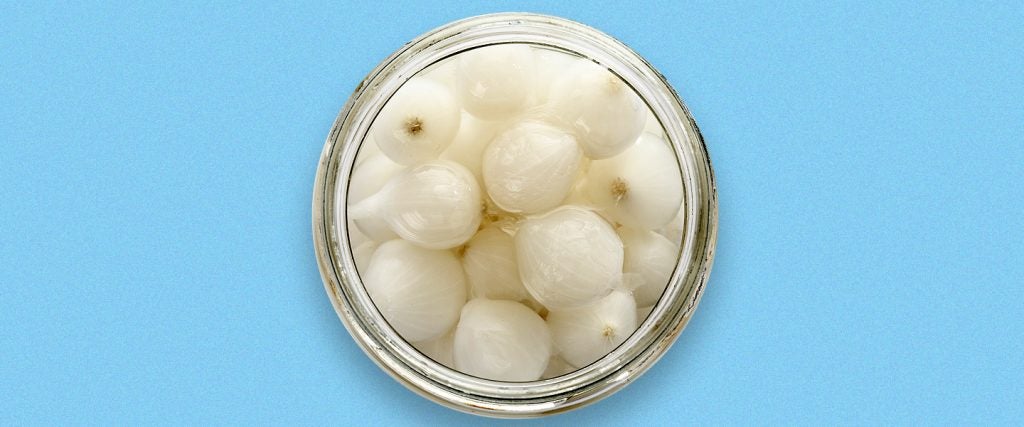Despite having “cocktail” in the name, cocktail onions are rarely called upon as a boozy accoutrement and/or garnish. Even the Bloody Mary, a brunch staple here in the Midwest for all the different foodstuffs that can be skewered with it, almost never involves cocktail onions. So why then do so many grocery stores have shelves full of cocktail onions? Like the bag of minced raw onion in the back of my fridge, something stinks.
To start, cocktail onions are pickled pearl onions, and pre-pickling, pearl onions are a cherished member of the onion family. In their raw form, they’re crisp and bitter, but with a toned-down, sweeter taste than other onions. What’s more, because they’re much smaller than their bulbous brethren, pearl onions are a natural choice for stuffing into jars with a salty brine for preservation.
But how that jar of pickled pearl onions made its way into being a “cocktail onion” is where the story gets a bit less clear. There are numerous theories as to who invented the “Gibson,” the gin martini that employs the pickled pearl onion as a garnish. Per one account, the Gibson was created when a man named Charles Dana Gibson asked a bartender in New York City for a “fresh take” on a gin martini. In response, the bartender replaced the martini’s olive with a pickled onion. A second theory ascribes a similar story, only in this account the namesake patron was Walter D.K. Gibson, and a third claims the cocktail was actually named after a California onion farmer.
It seems the cocktail onion either became an onion for cocktails at the behest of Big Onion, or because it was simply within reach of a lazy bartender.
Over a century later, however, the Gibson remains the only mixed drink that specifically calls for a cocktail onion — and is famous for doing so. In other words, the cocktail onion didn’t necessarily become the staple garnish it makes itself out to be. “Maybe we’re overlooking an essential and don’t know it,” says Dean Serneels, a renowned mixologist and 30-year veteran of the bartending industry. “But I’m wondering if the Gibson and its cocktail onion should’ve been sent to cocktail heaven years ago.”
If sheer popularity in the alcohol industry didn’t launch countless jars of cocktail onions into every grocery store across the country, what did? I begged anyone in the onion industry for further insight, but not a single onion expert, onion producer, onion distributor or member of the National Onion Association would give me any satisfying answers. “I’m sorry,” a representative for the “leading digital news source for the onion industry,” Onion Business tells me, “we won’t be able to help you.”
Maybe those responsible for pickling them would have more answers. To find out, I reached out to California-based food processing company Mezzetta, among the country’s foremost leaders in pickled onions and the very brand whose jars taunt me at my local grocery store. According to Rachel Perry, a spokesperson for Mezzetta, cocktail onions “have been a staple of the company’s portfolio for decades.” In fact, she adds, Mezetta’s sales of cocktail onions have “seen double digit growth in just the past couple of years.”
Part of the reason cocktail onions have remained so popular is their inclusion in cocktails, of course, but the bigger reason is likely that pickled pearl onions are an essential ingredient for savory dishes in need of some lightening up. “Their crisp yet tender texture and tangy flavor make them a fantastic addition to a beef stew or hearty braise,” Perry explains, “[because they] act as a pop of acid against the richness of the recipe.”
And so, I stand corrected. Not only are cocktail onions much more than some sham garnish for a cocktail that no one drinks, they’re proof that I need to start learning some new recipes and expand my knowledge of vegetables beyond the rim of a Bloody Mary.

